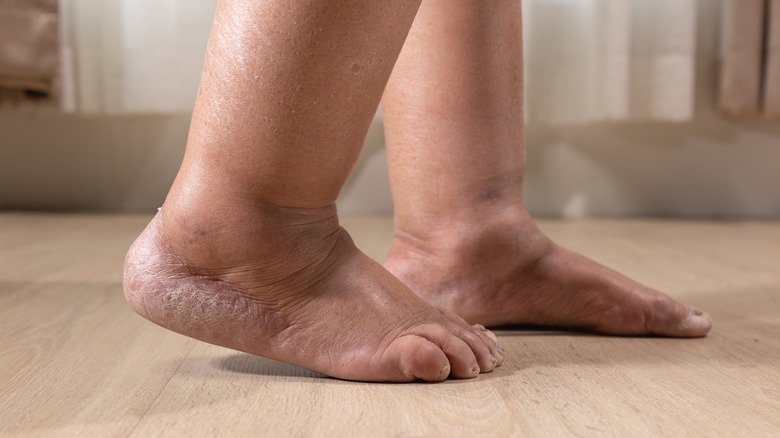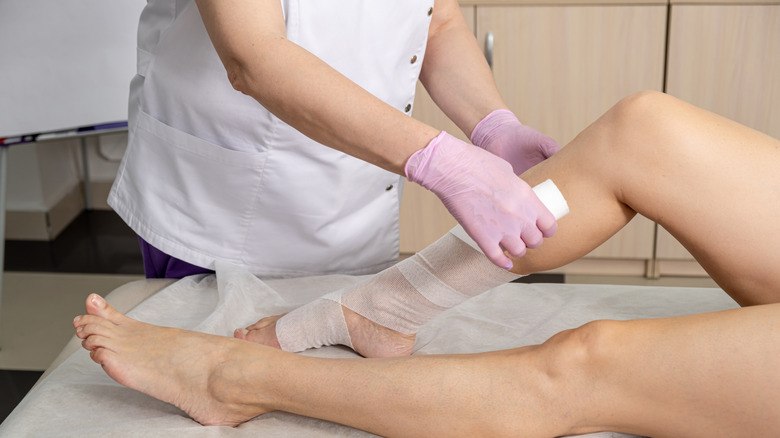4 Signs Your Swollen Feet Might Require A Trip To The Doctor
After taking off your socks at night, you notice that your feet are a little swollen. Should you be worried? Most of the time, slightly swollen ankles aren't a cause for concern, especially in people who have been on their feet all day or have participated in vigorous movement. This swelling, which occurs when too much fluid gets trapped in the body's tissues, is called edema, and it's common in the legs and feet (via WebMD).
While edema isn't necessarily a reason to be alarmed, you'll want to see a medical professional when the swelling is severe. For example, if your ankles hold a dimple when you press into them, this is abnormal swelling. You might also want to look for accompanying symptoms like discoloration, fever, or heat. Severe swelling during pregnancy is also a cause for concern.
Take the heat off your feet by learning when swollen ankles mean more than just a need to sit down and relax.
Pain and discoloration can mean something is afoot
Swelling can be scary when it seems like it comes from nowhere. But if you notice swelling with discoloration and pain, you might have damaged your underlying bones, nerves, or tendons. The discoloration comes from bruising, where the blood vessels leak under the skin at the point of the trauma (via the Cleveland Clinic). The swelling and discoloration might have an obvious cause, like when you trip over a dog toy in your living room and sprain your ankle.
However, you can also be injured without sudden force. PennState Health noted that foot swelling and pain can be due to a stress fracture. This is where the bone breaks due to repeated stress from exercise or hard physical labor. It's common in the bones in the back and middle of the foot, but it can happen on any part with enough repeat pressure. For example, you might get a Jones fracture, which is a break of the bone on the outside of the foot.
Discoloration and swelling from sprains or fractures require diagnostic testing and treatment, such as a cast or brace. You'll need to rest and ice the affected foot.
Swelling and redness could be serious
Redness and swelling on your feet shouldn't be taken lightly, especially if they stem from a cut or rash. Feet are breeding grounds for infections due to their warm, moist environment. This makes cleaning and bandaging cuts and abrasions on the feet vital. However, even with the most dedicated care, bacteria and fungus can find their way into your foot, leading to an infection (via Podiatry Hotline Food & Ankle).
Red, itchy skin with blisters surrounding it is a signal of athlete's foot, which is a fungal infection (via WebMD). The fungi that cause athlete's foot thrive in warm, damp environments and can easily be picked up from a locker room floor. Meanwhile, Healthline states that redness, fever, and oozing from a cut or scrap are signs of a bacterial infection.
An ingrown toenail could also cause redness, swelling, and pain (via Mayo Clinic). This is where the toenail grows into the soft flesh, leading to pain and inflamed skin. Without treatment, it can become infected, spreading to other foot areas. Treatment of the redness and swelling depends on the cause, but can include anti-fungal medications and antibiotics.
Abnormal skin temperature should be monitored
Normal swelling doesn't cause any changes in the temperature of your feet. But if you've got swelling in your feet and heat in the foot or calf, it's a cause for concern, because specific disorders lead to narrower-than-normal openings or blockages in the arteries and veins. For example, chronic venous insufficiency is a disorder where the leg veins don't allow blood to flow correctly, leading to pooling in your legs (via Johns Hopkins Medicine). People who suffer from this have elevated temperatures in their skin, per an article in the Journal of Vascular Nursing.
Additionally, when the blood clots abnormally in the leg due to an underlying disorder, pregnancy, injury, or environmental factors, it can lead to deep vein thrombosis. According to the Mayo Clinic, the blood clot forms deep within the artery of the thigh or calf, causing a change of color, swelling of the leg and foot, soreness, and heat in the skin. Deep vein thrombosis can be dangerous because the clot can break off and travel to other body areas.
Diagnostic testing is needed to determine if your inflammation and warmth are from sinister causes. Treatment might include compression garments and devices, exercise, therapy, and medication.
Watch out for severe swelling in pregnancy
Pregnancy can lead to swelling in the hands and feet, per the NHS. This is because your body holds more water than usual during pregnancy, commonly accumulating in the extremities. It's usually worse after a long day and when you've been on your feet more than usual. However, extreme swelling can also be a symptom of a condition known as preeclampsia.
According to WebMD, this condition doesn't have a specific cause but could be related to genes or the placenta. It typically happens late in pregnancy and comes with severe weight gain, excess protein content in urine, and high blood pressure. Some pregnant individuals may also experience shoulder and belly pain, headaches, dizziness, and nausea. Specific risk factors for preeclampsia include being a first-time mom, experiencing preeclampsia during a previous pregnancy, having a family history, carrying multiple babies, and having high blood pressure (per the American Pregnancy Association).
Treatment depends on the symptoms and the stage of the pregnancy. Mild cases can be treated with bed rest, specifically laying on your left side, less salt consumption, and drinking more water. Severe preeclampsia requires surgery immediately for the health of the pregnant individual and child, especially those close to term. Other measures, like medication and diet changes, might be prescribed for pregnancies not close to term.





